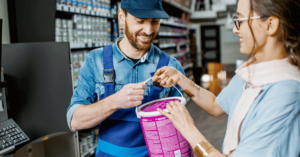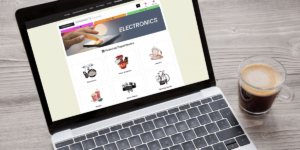Often it seems like B2C marketers get to have all the fun stuff. Viral Twitter hashtags, tear-jerker commercials, the attention of a big audience, and customer loyalty programs. But wait! B2C doesn’t get it all when it comes to customer loyalty programs. There are a lot of effective ways B2B marketers can influence their customers with a loyalty program. While B2B loyalty programs should be set up a little differently than B2C ones, it doesn’t mean loyalty programs are only for B2C companies.
Here are a few key B2B loyalty program differences:
1. B2B loyalty programs require more personalization.
According to The B2B Executive Playbook, a major difference between B2B and B2C companies is the size of their customer bases. An example? Successful B2C company Starbucks has about 15 million customers. Just as successful, B2B company Celestica only has ten.
B2B companies have smaller customer bases. So customer loyalty programs should personalize the participant experience.
Targeted communications
Communicate with B2B loyalty program members in ways that match their preferences. Today’s customers are a diverse, busy bunch. They demand communication options that fit with their on-the-go their lifestyles. To keep up, your loyalty program software should be able to send alerts and updates through many mediums. This helps you reach your customers where they hangout online.
How do you know what your participant’s preferences are? Simple – a form during open enrollment. These forms capture participants’ preferences when they sign up for your program. The form gives you accurate customer contact information. So participants always know where to expect loyalty program information to come from.
Personalization
With a small customer base, some say it’s risky for B2B customers to experiment with marketing. But having a smaller customer base isn’t a setback – it’s a benefit. Because B2B companies court smaller customer bases, they can invest in personalized marketing. Many studies show that even small acts – such as adding a recipient’s name to an email – yields 6x higher transaction rates. That’s compared to non-personalized emails.
Got an online loyalty program that rewards participants with digital points? You can personalize their shopping experience! Online reward catalog profiles can display avatars, pull reward histories, track reward point balances or suggest wishlist items. This information can be used to communicate and market to your participants.
Begin earning B2B loyalty with the right tools and strategies.
2. B2B companies should reward VIP customers with VIP loyalty rewards.
If you’re like most B2B companies, you likely have less than five truly loyal customers who affect your business. Investing in them retains their business and keeps yours afloat. Here’s how:
One-in-a-lifetime incentive trips
Treating your VIP customers to an incentive trip can help you build stronger bonds with them through a shared, unique experience. Are customers going to be more loyal to your competition? Or, to you, the person who stood beside them when they reeled a giant Atlantic sailfish out of the Caribbean Sea?
Incentive travel with top customers shows them how much you appreciate their business. Even more, incentive trips create long-term positive associations with your brand. These excursions offer up a relaxed space where you can truly get to know customers while sharing marketing strategies.
Memorable rewards
Find an incentive company that helps you give unique rewards to your customers. Long-term, dependable customers deserve more for their continued loyalty. Imagine if your participants could spend their points on a child’s college tuition, a home renovation, or indoor pool installation. Unique incentive rewards impact on customers’ lives more than traditional rewards. How much better could the customer experience get than that?
3. B2B loyalty programs should have training incentives.
-
- Customers and salespeople are often one and the same in channel sales. Contractors may buy from you, or sell your products. Maybe dealers or distributors manage sales reps who push your product to end-customers. Either way, you depend on customer product knowledge. Starbucks, like many B2C companies, doesn’t depend on customers knowing what’s in their drinks.
Good online loyalty programs deliver training and reward distribution through the same software. Customers can complete surveys, take quizzes, answer daily trivia and immediately get rewarded. Your customers can complete surveys, pass quizzes, participate in daily trivia questions and immediately receive rewards for doing so. Offering training incentives with a loyalty program is a simple way to join marketing efforts and boost product knowledge.
4. B2B loyalty programs can help B2B companies differentiate themselves from the competition.
-
- Today, it may seem as if every major B2C company with a loyalty or rewards program has a competitor who offers something similar. Think about Starbucks, credit card reward programs, Publix versus Kroger and more. B2B companies have been slow to do the same, citing complex sales channels as the major roadblock. But online loyalty software has evolved to handle the demands of most B2B companies, including marketing, authenticating and redeeming in-platform.
B2B companies are limited in how much product differentiation they offer because of industry standards. This means that B2B loyalty programs can have a bigger impact than its B2C counterparts. B2B loyalty programs are a strong differentiator for similarly manufactured and regulated products.
5. It’s essential that B2B loyalty programs have claims verification features.
-
- B2C companies sell their own products directly to the buyer. But your contractors and dealers sell to your end-users. This means you need claims documentation to confirm purchases. In the past, this has been time-consuming and an administrative burden. Claims validation issues was a major reason B2B companies avoided loyalty programs.
The best B2B loyalty programs have tools that speed up the claims verification and reward redemption process. For example, sales reps can upload invoices, receipts, warranty registrations and more to your program. That way, you can authenticate claims faster, and participants get to enjoy their rewards sooner.
A B2B customer loyalty program may not be as easy as swiping a coffee shop rewards card. But done the right way, B2B loyalty programs can make a huge impact on sales and marketing goals.
Begin earning B2B loyalty with the right tools and strategies



